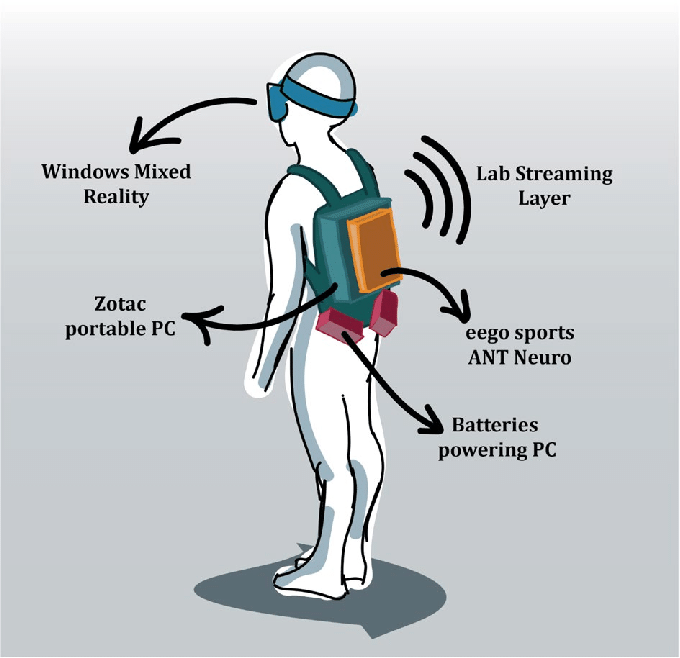This research uses a Mobile Brain/Body Imaging (MoBI) setup to study how architectural design impacts human cognition through immersive virtual reality. The illustration shows a participant wearing a mobile EEG system and VR headset, enabling brain data collection during free movement. Led by Dr. Zakaria Djebbara, the project reveals how architectural affordances shape perception, movement, and mental states in real-time.
Meet the Researcher

A Danish with Algerian roots, Dr. Zakaria Djebbara, defended his doctoral degree in which he combined architecture with cognitive neuroscience in 2020. Currently a post-doctoral candidate at the Department of Architecture, Design and Media Technology at Aalborg University, his research focuses on how architecture impacts human cognition and experience. He makes use of ecologically valid setups and neuroimaging analyses techniques to investigate manipulated affordances in
architectural transitions. Throughout his career, Dr. Djebbara has explored concepts in thedomain of architecture and philosophy and aspires to develop a foundation for architectsto understand the neurophysiological impact of their designs during routine, day-to-day tasks. This motivation has allowed him to become a pioneer in this research domain, and his research projects have received several awards. Noteworthy in his list of achievements, is the MoBI award conferred to him in 2020 and the Spar Nord Foundation’s Research Prize awarded to him in 2021.
A1. I would like to work towards understanding the impact that architectural design has on the well-being and mental health of humans. In other words, I aspire to better understand how the afforded features in the built environment implicitly affects behavior, cognition, and thus human experience. This encompasses human capacities such as perception, overt/covert attention, memory, navigation, learning, decision-making, and much more.
My studies are deeply interdisciplinary and rooted in concepts such as neurophenomenology, enactivism, and active inference because the depth of answers I seek are inherently multilayered. My goal is to be able to refine design tools employed by architects, to enable qualified predictions on how designed spaces are perceived. To achieve this, I aim to create systematic experiments and correlate the observed brain activity with behavioral measures.
A2. We use a Mobile Brain/Body Imaging (MoBI) approach to record brain activity synchronized with a head-mounted Virtual Reality (VR) display. This setup allows us to investigate the impact of architectural affordances on human cognition and brain dynamics in participants actively moving through virtual spaces. Our experiments are conducted in the Berlin Mobile Brain/Body Imaging Laboratories (BeMoBIL) where the physical space is about 160m². Within this space, two virtual rooms of 4.5m x 5m each, were created. Participants were led into a room containing one door of varying widths and thereby providing different affordances in the form of environmental stimuli that allowed or prohibited transitions between rooms. We wanted to explore differences in motor-related cortical potentials (MRCP) observed as a function of environmental affordances when participants were exposed to varying affordances. We thus expected to find cortical response differences and correlations between these responses as a function of affordances over sensory and motor areas. The experimental paradigm was a repeated-measures design where the factors ‘pseudorandomized door width’ (narrow, mid, wide) and ‘movement instructions’ (Go, NoGo) were included (Djebbara, 2021).
It was crucial to this approach that EEG data can be acquired continuously, while the subject kept moving and interacted with the virtual environment based on Unity. Thereby, we utilize the eego™ sport 64-channel EEG system and load the amplifier and the high-performance gaming computer (Zotac) onto a backpack that allows the participant to remain mobile. The Zotac system renders the VR environment and has a Windows Mixed Reality headset connected to it (Figure 1). All data streams are recorded and synchronized using the Lab Streaming Layer (LSL) protocol.
Study specific questions:
Based on brain dynamics of architectural affordances publications (Djebbara et al., 2019, 2021)
The experiment allowed us to collect subjective, behavioral, and electrophysiological data, with a focus on electrophysiology. Subjective data was collected from the Self-Assessment Manikin (SAM) questionnaire that is a pictorial assessment of pleasure, arousal, and dominance on a given scale. The participants were asked to self-assess their current state after each trial. Behavioral data were acquired based on door-approaching time, only for “Go” trials. Here, the time taken was statistically analyzed using a one-way ANOVA that used repeated measures for different door widths. Lastly, electrophysiological data were analyzed by examining early evoked related potentials (ERPs). Specifically, anterior and posterior P1/ N1 complex, early post imperative complex (EPIC), and post imperative negative variation (PINV) were all analyzed using the statistical ANOVA tests to compare significant differences [2].

Fig.1; The illustration depicts the MoBI setup used during the experiment. The participants wore a backpack carrying a high-performance gaming computer (Zotac, blue) powered by two batteries (red). An EEG amplifier (ANT Neuro, eego™ sports, yellow) was attached to the backpack and connected to the computer. The participants wore a VR head-mounted display (Windows Mixed Reality) on top of a 64-channel cap. This setup allowed patients to move freely around while recording data (Djebbara, 2021)[1]
Moving in space is to continuously construct a prediction of a world that we perceive as dependent on our action potentials that in turn is manifested in cortical oscillations. These results indicate that moving in space is to continuously construct a prediction of a world of affordances, suggesting that architects take up the continuity of spaces, given that the unfolding of bodily movement alters perception and experience. Additionally, the embodiment factor suggests that we are highly dependent on prior experiences of interactions. This suggests that users of space hold a principle of anticipation based on prior experiences that architects should keep in mind when designing the context for actions. The continuity essentially means that both prior and forthcoming spaces affect us.
Our findings provide strong evidence in favor of the hypothesis that affordances and actions do indeed influence the experience of an environment. The fact that we are mobile and predictive beings suggests that architects should take the temporal aspect as seriously as the spatial aspect. The predictive process of unfolding bodily movement can alter the perception of space. Moving and transitioning in space is to continuously construct a prediction of a world that we perceive as dependent on our action potentials, which informs brain, body, and mind. Altering perception would ultimately lead spaces to have a physiological impact on users. Much remains to be uncovered in architectural cognition.[2]
Our current study explores how architectural affordances relate to the
attentional mechanisms underlying the gating function for sensory signals both upon perceiving the environment and during the interaction with the environment, are induced. We can further explore how architectural design may implicitly, but constantly, influence subcortical structures that in turn project to numerous other regions in the brain. Another proposed work could be to use architectural design as a medium for investigating actionselection and sensorimotor integration with the help of the MoBI setup.
eego™ solutions in mobile setups
In mobile setups, it is imperative that participants remain free to move about and that the experiment setup mimics real-life scenarios. The lightweight feature and mobility offered by the eego™ system makes it feasible for the system components to be carried around in a backpack together with the Zotac PC that is used for displaying the VR environment. The waveguard™ original 64-channel electrode caps have no loose cables flying around and therefore the hardware arrangement remains comfortable with the VR device placed on top of it. This has also significantly reduced the preparation time of participants. In combination with the active shielding technology implemented between the eego amplifier and the EEG cap, this setup effectively counteracts interference of electromagnetic and mechanical noise sources that are commonly encountered in demanding innovative studies. The eego acquisition software is LSL compatible and can therefore receive software events for post-hoc synchronizations and can stream EEG data out to other platforms such as the most commonly used LabRecorder.
References
